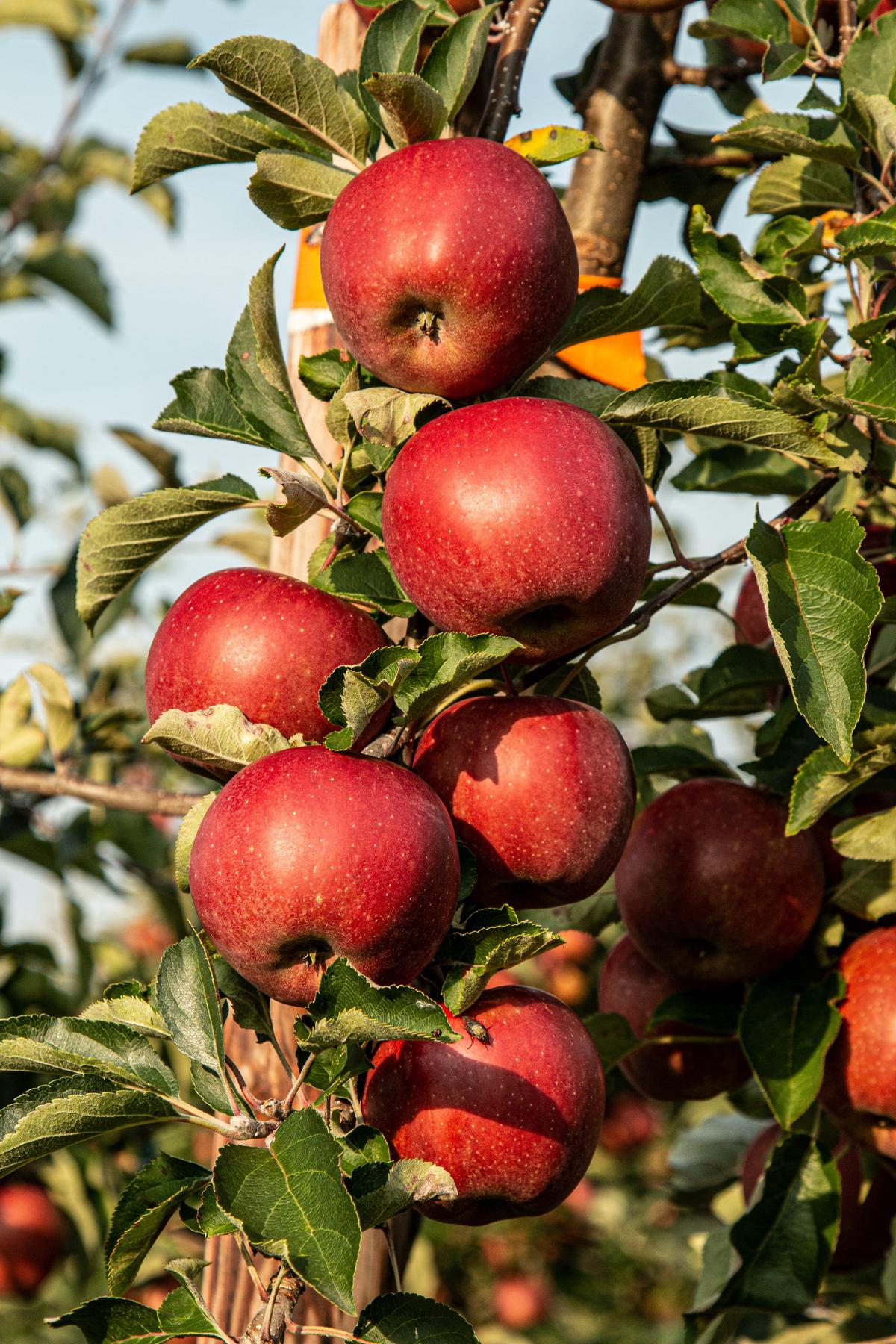Genetically modified (GM) apples, representing a new pinnacle of scientific achievement, have been the center of many discussions revolving around innovation, public health, and environmental responsibility. Grounded in intricate technology which alters the genetic makeup of the apples, these advanced specimens not only offer improved characteristics, but also create various implications for agriculture, legislation and public opinion. An exploration into what these GM apples are, the process of their creation, their perceived benefits, risks, and the impact they might have on farming and food industry, can provide a clear, balanced understanding of this remarkable venture. So too can insight into what the future might hold for these modified fruits, given the ever-evolving nature of scientific research and public sentiment.
What are genetically modified apples?
Genetically modified (GM) apples
Genetically modified (GM) apples are apples that have had their genetic material altered through genetic engineering techniques. Genetic engineering involves the direct manipulation of an organism’s genes using biotechnology.
Altering Apple Genes
This technology allows scientists to introduce, enhance, or suppress specific traits within the apple. For instance, they can alter the apple’s genes to make it more resistant to diseases, pests, or extreme weather conditions. Other modifications might include enhancing the apple’s nutritional value, increasing its shelf life, changing its color or flavor, and reducing its tendency to bruise or brown when cut.
Methods of Genetic Modification
There are multiple methods used for genetically modifying apples. One common way is through agrobacterium-mediated transformation, where a plasmid (a small circular piece of DNA) from the agrobacterium is used to insert a new gene into the apple’s DNA. Another method involves the use of a gene gun, which propels gold particles coated with the desired DNA into the apple’s cells. Alternatively, scientists can use CRISPR-Cas9, a newer technique that allows for precise, targeted changes to the DNA.
Purposes of Genetic Modification
The intention behind genetically modifying apples varies. Some of the modifications aim at increasing the yield or improving the quality of the fruit. Others are designed to make the apples resistant to common apple diseases like apple scab or fire blight, reducing the need for chemical pesticides. Some are targeted towards consumer preferences like non-browning apples, that retain their fresh appearance even after being cut open.
The Arctic Apple
One of the most well-known genetically modified apples is the Arctic Apple. This apple variety has been modified to suppress the production of polyphenol oxidase (PPO), an enzyme that drives the browning process. When these apples are cut, bitten, or bruised, they retain their original color.
Distinguishing GM Apples
These GM apples are distinguishable from traditional apples by their extended shelf life and altered physical and chemical characteristics. Their nutritional profile may also be enhanced, for example, boosting levels of antioxidants or vitamins. In addition, they may exhibit increased resistance to pests, diseases, and harsh environmental conditions.
Controversies Surrounding GM Apples
The use and consumption of genetically modified apples, as with any GM food, are controversial. Critics argue the long term health effects of eating GM foods aren’t entirely known and that GM crops could negatively impact biodiversity. Advocates, on the other hand, note the potential increased yields and improvements in fruit quality, the reduction in pesticide use, and the possible benefits to combating climate change due to increased resilience.
Regulation and Safety
It’s worth noting that GM apple varieties must undergo rigorous testing and regulation before they’re approved for commercial sale and human consumption. These regulations help ensure that GM apples are as safe to eat and as environmentally sustainable as traditional apple varieties.
Exploring the Horizon of GM Apples
With the looming potential that genetic modification presents for food production and security, it stands as an influential factor in the future transformations of agriculture. Of course, this complex technology requires vigilant governance to mitigate any possible threats and ensure its contribution to sustainability and equity. As it evolves, we can expect alterations in the way we grow, harvest, and consume food.

The development and regulation of genetically modified apples
Dawning of Genetically Modified Apples
The inception of genetically modified (GM) apples can be traced back to late 20th Century when the Flavr Savr tomato set the precedent for genetically engineering a wide range of crops, back in 1994. The momentum continued with apple-modification experiments, aiming at enhancing their resistance to common diseases, prolonging their shelf-life, and bettering quality.
Leaping to the forefront of this sphere was Canada’s ‘Arctic apple’, developed by Okanagan Specialty Fruits Inc. These apples were subjected to genetic modifications to delay browning when they’re cut, using a technique known as gene silencing or RNA interference (RNAi). This process successfully prevents the creation of polyphenol oxidases (PPO), the enzymes responsible for the browning of the cut fruit.
The Arctic apples, introduced as Golden, Granny, and Fuji, gained U.S. approval in 2015 and 2017, respectively. They finally graced the U.S. marketplace by 2019.
Adding to the roster of GM apples is ‘BriteLite’, the brainchild of researchers at Washington State University. Implanting an extra gene causes BriteLite apples to produce anthocyanins, powerful antioxidants, at levels seven times higher than the norm. These compounds hold the potential to reduce the risks of various health concerns, including cancer and heart diseases.
Regulation of Genetically Modified Apples
Before making their way to grocery store shelves, genetically modified apples must go through rigorous assessment and gain approval from three U.S. government agencies: the United States Department of Agriculture (USDA), the Environmental Protection Agency (EPA), and the Food and Drug Administration (FDA).
The USDA’s role is to examine whether the GM apple could pose a risk to other plants. If it decides not to regulate the fruit, this means it has determined that the genetically engineered (GE) apple is no more of a plant pest risk than a conventional apple.
The EPA reviews any new proteins expressed in the GM apple for potential toxicity or allergenicity. They also regulate the pesticides used on these crops and ensure that they do not pose unreasonable risks to human health or the environment.
Lastly, the FDA evaluates the safety of the GM apples for human consumption, after reviewing the biochemical and nutritional profiles and performing appropriate allergenicity testing. They ensure that the genetically modified food, such as GM apples, is safe to eat and contains the same nutrients as its natural counterpart.
Public Safety and Health Measures
It is imperative to note that GM apples, prior to reaching consumer plates, would have passed stringent safety tests. These tests are designed to ensure that they are not harmful to consume and do not trigger any allergenic reactions. Additionally, the GM cultivation process keeps in mind environmental safety to prevent potential harm to surrounding ecosystems.
The Institute of Medicine and the National Research Council, based on a review of many scientific studies, have stated that GM foods are no riskier than foods resulting from traditional breeding methods. These food products are assessed for safety, and the GM apple adheres to their benchmark by maintaining nutritional equivalence and posing no sustained risks.
Introduction to Genetically Modified Apples
With a delicate balance between technological innovation and regulatory oversight, the development of genetically modified (GM) apples has undergone meticulous examination by respective governmental bodies. The primary aim of these rigorous checks and balances is to ensure the safety of consumption of these GM apples and the preservation of environmental health. These cutting-edge modifications encompass improvements to the nutritional content, enhanced taste and texture of the fruit, and an extended shelf-life. Truly, these advances unlock remarkable potential for our favorite orchard product.

Photo by priscilladupreez on Unsplash
Benefits and risks of genetically modified apples
The Perks of Genetically Modified Apples
Engineered for numerous gains, GM apples possess certain characteristics that make them more attractive and useful in both agriculture and food production. These alterations have been carefully designed to bring forth desirable and beneficial traits that offer both economic and aesthetic value.
One of the latest innovations in the realm of GM apples is the creation of the “non-browning” variants. These apples are genetically tailored to inhibit the activity of the enzyme polyphenol oxidase (PPO), which is known to cause browning in apples when they’re cut or bruised. These modifications help prolong the apple’s freshness once it’s been sliced open, making it more desirable to consumers and playing a significant role in reducing food wastage.
The GM versions like the Arctic Apple varieties are also imbued with heightened resistance against diseases. They’ve been technologically altered to have robust defences against common afflictions and pests that often harm apple crops, such as apple scab, fire blight, or codling moth. Thanks to this trait, farmers can lessen their reliance on pesticides, potentially increase their yield, and reduce the environmental footprint of apple farming.
Potential Risks and Controversies of Genetically Modified Apples
Despite these benefits, there are potential risks and controversies associated with GM apples. One of the main concerns is the potential for genetic cross-contamination between GM apples and non-GM apples. This can occur primarily through cross-pollination, the process where pollen from one apple variety is transferred to another by wind, insects, or birds.
This could pose a risk to organic apple orchards. If an organic apple tree is fertilized by pollen from a GMO apple tree, it could interfere with the organic certification of that farmers’ entire crop, potentially causing severe financial loss.
There is also a concern about the potential health impacts of consuming genetically modified organisms, including GM apples. While many scientific authorities have deemed GM foods safe for consumption, some consumers remain skeptical. This public apprehension can lead to economic repercussions, as seen in several countries worldwide that place strict regulations on GM foods or outright ban their cultivation.
These controversies also extend to ethical implications, such as the rights of farmers and consumers to information about whether their crops or foods contain genetically modified organisms. Many argue that the right to know what is in one’s food is fundamentally important, leading to calls for labeling of genetically modified foods.
Environmental risks are also a concern, primarily regarding the increase in pesticide resistance in pests. The more we use these genetically modified crops, the more likely pests and diseases will evolve to resist them, creating a perpetual cycle that could eventually lead to stronger, more resistant pests and more potent pesticides.
While the introduction of genetically modified (GM) apples into the world of agriculture and our food supply has its undeniable benefits, it’s important to equally consider the potential repercussions on the health of consumers, the environment, and agricultural market trends. These advantages and risks should be discussed in an open forum, ensuring the conversation around these genetically modified organisms (GMOs) remains transparent and ongoing.

Public opinion and impact on apple industry
Perceptions Surrounding Genetically Modified Apples
Public sentiment regarding genetically modified apples varies greatly, largely shaped by an individual’s scientific literacy, personal values, and societal influences. A considerable number of individuals convey apprehension over the perceived health threats that GM foods might present, often based on a broader distrust of genetic modification. This uncertainty often stems from the complexities of genetic sciences and the mistaken belief that all GMOs are inherently harmful to human health.
However, proponents of genetically modified apples challenge these fears with a range of scientific evidence. They argue that GM apples, such as the Arctic apple – the first GM apple to be commercially available in the U.S.- are as safe for consumption as their traditional counterparts. In this case, the genetic modification is employed to delay the browning process of the apple, a change that has no effect on its nutritional value or allergenic properties.
Supporters of GM apples point to the practical and economic benefits, such as decreased food waste, extended shelf life, and reduced production expenses. They also applaud the scientific progress that genetic modification encapsulates. Besides, some consumers find the improved taste and texture that some GM apples provide to be a compelling factor.
Impact on the Apple Farming Industry
The introduction of genetically modified apples has notable potential to impact the apple farming industry. In areas where pests or diseases are a significant issue, GM apples that have been engineered for resistance to certain pests or diseases can provide a solution. This can lead to lower production costs, less use of pesticides, and higher overall yields.
However, the GM apple farming comes with its own set of challenges. Cross-contamination is a primary concern; pollen from GM apple trees can potentially spread to conventional apple trees, creating regulatory and marketing difficulties for farmers who wish to sell their crops as non-GM. This can also lead to a loss of biodiversity in apple varieties.
Impact on the Overall Food Industry
The overarching food industry is influenced too by the production of GM apples. Food producers who utilize apples as a key ingredient might benefit from the extended shelf life of GM apples that don’t brown easily. This doesn’t only improve cosmetic appeal for processed apple products like slices, juice, and puree, but also offers cost benefits.
Conversely, the food industry also needs to grapple with regulatory considerations and transparency in marketing. Stringent regulations and approval processes need to be met before GM foods like GM apples can be commercialized. Furthermore, food labeling standards often require disclosure of GM ingredients, and this can influence consumer choice for those who prefer to avoid GMOs.
Public opinion on genetically modified apples stands at a crossroads, oscillating between cautious skepticism and acceptance. This mirrors a state of flux within the apple and broader food industry, as they adjust to the burgeoning prevalence of these scientifically augmented fruits.

Future of genetically modified apples
The Nutritional Potential of Genetically Modified Apples
Harnessing the technology of genetic modification, apples have the potential to offer enhanced nutritional benefits. By introducing alterations at the genetic level, the concentrations of beneficial nutrients like antioxidants, vitamins, and dietary fibers can be bolstered. As this field advances, we could see apples with increased Vitamin C or iron. There are also possibilities for producing apples deliberately high in antioxidants, offering potential health advantages.
Improved Disease and Pest Resistance in Genetically Modified Apples
Scientists are continually researching ways to increase resistance to diseases and pests in GM apples. Future developments could potentially include apples that are engineered to be resistant to specific pests or diseases. This would significantly reduce the reliance on pesticides, which comes with environmental and health benefits. Consumer attitudes towards these apples could improve if they offer a more eco-friendly alternative to conventional apple farming.
Future Applications of CRISPR Technology in Apple Modification
One of the promising tools in the field of genetic modification is the CRISPR-Cas9 technology. Its applications in apple modification could transform the future of the apple industry. The potential to edit the genes of the apple tree using this technology allows quick and precise changes, such as altering the apple’s taste, texture, and size, or increasing its resistance to various diseases and environmental stresses.
Modified Apples for Food Processing Industry
In the food processing industry, the properties of an apple often matter as much as the taste. For instance, some apple varieties brown much quicker than others when cut, which is undesirable in processing for prepackaged salads, apple pies, or juices. Genetically modified apples could be engineered to resist browning or to have a longer shelf life. The so-called Arctic® apples are one early example of this: genetically modified for non-browning after being cut.
Potential Changes in Regulations and Public Attitudes Regarding GM Apples
Regulation of genetically modified foods, including apples, has been a topic of ongoing debate worldwide. The general trend is a growing call for more transparency and better labeling of GM products so consumers can make informed choices. The public attitude towards genetically modified apples has been a mixture of concern and acceptance. As the benefits of genetically modified apples become more apparent and if the regulatory bodies ensure rigorous safety assessments, public acceptance of these apples is expected to increase.
Future Research in Genetically Modified Apples
Research in the field of genetically modified apples is ever-evolving. Future studies are expected to focus on not only increasing disease resistance and enhancing nutritional benefits but also on addressing public concerns regarding GM products. Scientists are also working on establishing the long-term safety and effects of these apples on human health and the environment. This will ensure that any new apple variety introduced in the market is not only better in quality but is also environmentally sustainable and safe to consume.

The story of genetically modified apples is an ongoing narrative marked by scientific advancement, legislative politics, public sentiment, and industry dynamics. As agricultural practices continue to evolve, these innovative fruits promise impressive utility, but also carry possible risks. The diverse views from the public arena, alongside the industry’s responses reflect the complex, multifaceted nature of our food systems. The continued exploration and study of this curious intersection of technology, agriculture, and societal values no doubt will sketch an intriguing future not only for apples, but for the wider field of genetically modified foods at large.
